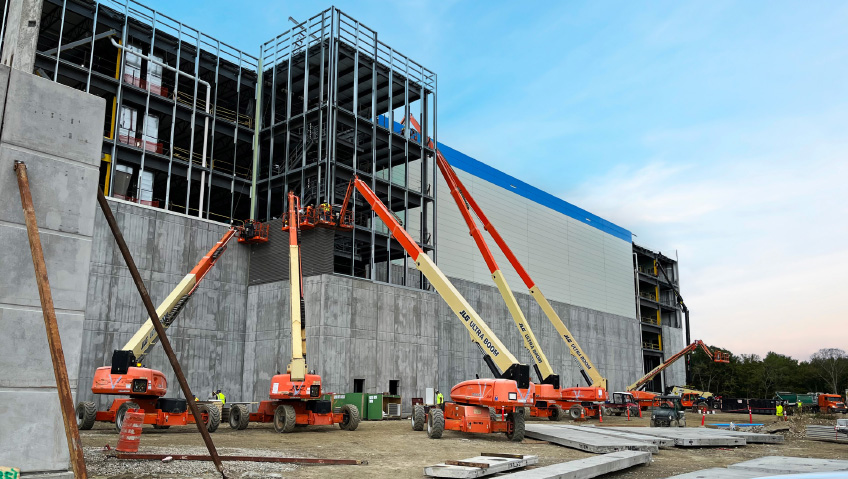Bob J. Quarture, Jr. seems awestruck as he describes how his workforce installed cladding on a 500-foot tower in Toledo, Ohio. Quarture is president of Mohawk Construction and Supply Company, Inc. of McMurray, Pennsylvania. The company designs, engineers, fabricates, and installs building cladding systems.
The Toledo tower was built for a company called Cleveland-Cliffs, which describes itself as “the largest flat-rolled steel provider in North America.” The client wanted the tower built quickly, in winter.
Not counting weather, heights, and a looming deadline, the Mohawk team faced another challenge. For a project like the Toledo tower, “exterior appendages such as piping, cable trays, and conduit trays,” are usually installed after cladding is put in place, Quarture points out
This tower, however, was erected in modules, with each premade section already containing outside piping and other appendages. These extrusions meant extreme care had to be taken when erecting scaffolding and rigging around the tower.
To describe the project as challenging would be “an understatement,” he says. “Kudos to our folks,” he says, saluting the workers who toiled on the tower. “They were operating in winds and winter conditions at 500 feet on scaffolding. That’s definitely a job I am very proud of and proud of the men on that project.”
The Toledo tower was completed in 2021, as the company’s workload began to return to life following a temporary dip during the worst of the COVID pandemic.
Difficult assignments are all par for the course at Mohawk Construction, where the team excels at projects involving building exteriors.
“We are a specialty contractor in the metal cladding arena. The caveat is, we don’t do glass, and we don’t do curtain walls for the most part but, along with metal cladding systems, there are stone veneer cladding systems; there is terracotta cladding; there are aluminum plate and aluminum composites. There are several different products that we use to clad the exterior beyond the metal product.”
Mohawk’s work can be categorized as either architectural or industrial. The architectural category covers commercial offices, colleges, universities, and hospitals, while industrial includes automotive plants, mining operations, steel manufacturing facilities, aluminum smelters, and power stations.
Project management, procurement and most fabrication work are handled in-house, while certain specialties such as structural and thermal performance or stamped drawings are usually subcontracted to engineering firms. Mohawk typically works in partnership with a general contractor. The company has established master subcontract agreements with some general contractors with which it does repeat business but remains open to new customers.
In addition to the head office in McMurray, the company maintains a warehouse and fabrication shop in Avella, Pennsylvania. It has an expansive reach and has taken on assignments in over half of the U.S. states, plus Canada and Puerto Rico.
“When people say, ‘Where do you go?’ I say, ‘We go until we hit water.’ We’ve done a tunnel to cruise ships in Miami, Florida; we’ve done the Louisiana [Veterans Affairs] hospital; we’ve done work in California, Arizona, and Nevada but our sweet spot is probably the area ten to twelve hours [from] Pittsburgh,” Quarture states.
Mohawk Construction and Supply Company was officially launched in 1980, but its roots go back to a firm called Viking Erectors. Back in the late 1960s and 1970s, Viking installed roof decking for building contractors and worked with decking suppliers in New Jersey and other locales. Viking and Mohawk, which has always been a contracting and supply company focused on metal panels, eventually merged. In October 2019, Quarture, a long-time Mohawk employee, purchased the entire company. He remains the sole owner today.
The company is composed of inter-related divisions, or ‘entities’ as Quarture prefers to call them. One entity handles administration, sales, and contracts while other entities are responsible for fabrication and additional services. The labor force that does the installation work still goes by the name Viking Erectors. On big assignments, Viking will augment its ranks with subcontractors.
While Mohawk offers start-to-finish services, clients occasionally hire the firm on a labor only basis. In such cases, the general contractor or client has already purchased materials and simply wants Mohawk to erect and install the cladding. For these jobs, “Viking takes the contract in their name directly with a client and performs the contract without Mohawk being involved,” explains Quarture.
The company’s upwards trajectory was blunted by the arrival of COIVD in early 2020. The pandemic had a direct impact on Mohawk Construction; one of the company co-founders died of the disease, and several projects were put on hold.
“Like everybody, we had a lot of ups and downs—a lot of downs at first. We had contracts cancelled. People really didn’t know what to do,” recalls Quarture.
Fortunately, some projects were considered essential, so Mohawk was able to continue working even as sales took a slump. During the worst of COVID, office staff members were given the opportunity to work remotely, while masks, hand sanitizer, distancing policies, and comprehensive cleaning efforts of tools, workspaces, break, and lunch rooms were implemented.
“Our sales kind of slacked off. Now, we have a backlog and seem to be doing a lot better,” Quarture states.
The company has roughly fifteen office staff and fifty-five iron workers in the field at present. The number of field workers expands if additional resources are required on a project. Field staff members are unionized, and Mohawk has “an international agreement with the ironworkers. Anywhere we travel in the U.S., most of the time, fifty percent of the guys we use are from the local union hall and fifty percent are our guys whom we send as travelers,” he explains.
The Toledo tower is not the only high-profile project in Mohawk’s portfolio. The company has also worked for Amazon in Ohio on assignments that entailed “a large requirement of manpower and equipment. We own a lot of our own equipment, man lifts, forklifts. Mobilizing that equipment, mobilizing the men [was a challenge],” says Quarture.
The company also worked on the Port Miami Tunnel, a recent initiative to create direct access between Florida highways and a seaport where ships dock. It received a $2 million contract to install a complicated architectural wall cladding system.
“I think the job required, at the high point, fifty-five or sixty guys. [We did] the supports and cladding on that tunnel, to and from the cruise port… The roadbed twists and turns in that tunnel. I think our guys did a phenomenal job with the layout. [They had] a very aggressive schedule. I think they performed admirably, and I know the customer was very, very happy,” Quarture says.
For all projects, Mohawk adheres to strict safety protocols. “By the very nature of our business, our work is fraught with peril. If you’re not aware of potential problems, then that is a problem,” he says, adding, “Our company men are very well-versed in our safety practices.”
Working with general contractors, Mohawk teams participate in weekly toolbox and safety meetings, while worksites undergo a job safety analysis to identify hazards and detail safety equipment requirements. Thanks to the company’s safety-first focus, Viking Erectors’ five-year experience modification rate (EMR) average is below 0.8. A low EMR—an insurance company formula that determines how likely it is that employees at a business will file workers’ compensation claims—indicates a good safety record.
Non-COVID-related challenges include difficulties in hiring personnel. Across North America, skilled trades workers are approaching retirement age, and insufficient numbers of young people are stepping up to take their place. Mohawk is doing its best to attract new workers.
On top of finding new staff, “There’s the passing of knowledge too. You don’t want all that knowledge [from retiring staff] to walk out the door and have a brain drain,” says Quarture, noting that the company wants to “transfer some of that knowledge base and the dos and don’ts of metal panel 101.”
Mohawk has brought in outside help as the company moves forward. It recently hired construction consultancy agency FMI to scrutinize its operations. This comprehensive review is expected to last between twelve and eighteen months. “We’re kind of reinventing ourselves,” says Quarture.
By engaging FMI, Mohawk hopes to enhance its performance, not jumpstart a rapid expansion, he is quick to add. “We’re a $25 to $3 million company. When FMI started with us, they’re like, ‘Bob, where do you want to grow the topline?’ I was like, ‘Whoa! I’m not worried about topline right now; I want to improve all our processes. Let’s do it right, then grow the topline,” he says.
He is confident that the company will expand, given its impressive track record, stellar staff, and excellent reputation. Making internal improvements is the priority for the time being, however.
“So, do we grow the topline between now and five years? Probably. But I’m more invested in being more efficient than just growing the business to say we grew the business,” states Quarture.






